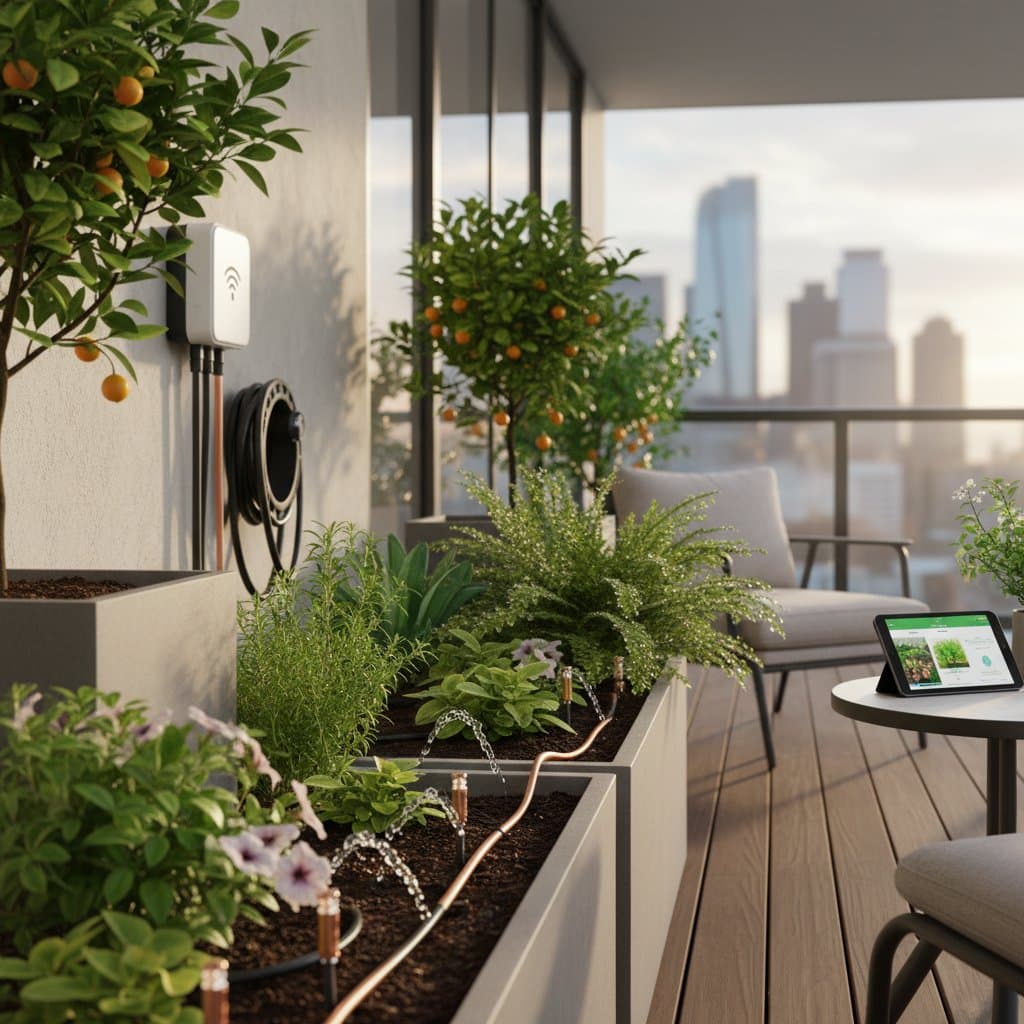Understanding Micro-Drip Irrigation
Micro-drip systems deliver water precisely to plant roots through a network of thin tubes and emitters. These setups mimic natural rainfall by releasing small, steady drops, which prevents soil erosion and ensures even moisture distribution. Ideal for urban balconies with limited space, such systems support a variety of potted plants, from herbs to flowers, while adapting to irregular watering schedules.
The core components include a water source, such as a faucet or reservoir, connected to flexible tubing. Emitters at each pot regulate flow, while a timer automates the process. This targeted approach minimizes evaporation and runoff, making it suitable for water-conscious gardeners in city environments.
Key Benefits for Urban Gardeners
Balcony dwellers often face challenges like unpredictable weather and tight schedules, which micro-drip systems address effectively. They conserve water by applying only what plants need, potentially halving usage compared to manual methods. This efficiency proves especially valuable during vacations, as the system operates independently to keep soil consistently moist.
Beyond water savings, these systems promote healthier growth by reducing overwatering risks, which can lead to root rot. Plants receive nutrients more efficiently, resulting in stronger stems and vibrant foliage. For those with multiple pots, the scalability allows expansion without complicating daily routines.
Essential Setup Guide
Begin by mapping your balcony layout to determine tubing lengths and emitter placements. Measure distances between pots and the water source, adding extra for adjustments. Gather supplies: main tubing, branch lines, emitters, a filter, pressure regulator, and timer.
Connect the filter to the faucet to prevent debris from clogging the lines. Attach the main tubing, then add branches to each pot, securing emitters near the soil base with stakes. Install the timer on the faucet for scheduled watering, starting with short sessions to test coverage.
Test the entire assembly by running water for five minutes, observing flow at each emitter. Adjust positions if some areas receive uneven moisture. Secure all connections with clamps to avoid drips, ensuring the system withstands wind or minor balcony movements.
Troubleshooting Common Issues
If certain pots appear dry, inspect emitters for blockages caused by dirt or mineral deposits. Flush the system by detaching the end cap and allowing water to run through for one full minute. This clears obstructions without disassembling the entire setup.
Excessive spray indicates high pressure; lower it at the faucet or add a regulator to maintain gentle drips. For leaks at joints, cut tubing ends squarely with sharp scissors and reinsert fittings firmly. Regular checks prevent minor problems from escalating into system failures.
Budget and Time Considerations
A basic setup for a small balcony typically ranges from 35 to 60 dollars, influenced by the timer model and emitter count. Allocate about two hours for planning, measuring, and installation, allowing time for testing. The timer and drippers represent the primary expenses, but investing in quality pieces ensures longevity.
Skip no component, particularly the filter, as clogs lead to uneven watering and potential plant loss. Source materials from garden centers or online suppliers for cost-effective options. Over time, the system pays for itself through reduced water bills and preserved plants.
Ongoing Maintenance Practices
Examine tubing monthly for wear or kinks that disrupt flow. Soak emitters in a vinegar solution for 15 minutes to dissolve algae or mineral buildup, then rinse thoroughly. Replace any cracked sections annually to maintain reliability, especially after exposure to sun or temperature shifts.
Before winter arrives, drain all water from the lines to prevent freezing damage. Store components in a dry area, uncoiling tubing gently to avoid creases. These steps extend the system's life, requiring minimal effort for consistent performance.
Efficient Storage Solutions
Organize spare tubing by coiling it loosely and placing it in a clearly labeled bin. Group replacement emitters, stakes, and connectors in a single resealable bag for quick access. Use colored tape to designate zones if future expansions are planned, simplifying modifications.
This methodical approach streamlines upkeep and troubleshooting. Keep tools like scissors and a small brush nearby for on-the-spot repairs. Proper storage ensures the system remains functional year-round, ready for seasonal adjustments.
Professional Assistance Options
Seek expert help if your balcony lacks an outdoor faucet or requires integration with a building water supply. A plumber can establish a secure connection in less than one hour, incorporating safety features. Specify needs for a vacuum breaker to avoid backflow and timer compatibility to control watering cycles.
Professionals also assess balcony structures for secure mounting, preventing sagging lines. This service costs more upfront but eliminates risks like leaks or structural issues. For complex installations, such as multi-level setups, their expertise ensures optimal results.
Implementing Your System
Activate your micro-drip setup this week by running a full cycle and monitoring soil moisture in each pot. Fine-tune emitter flow rates to achieve uniform dampness without saturation. Program the timer for daily or alternate-day sessions based on plant needs, then verify connections after the initial run.
With these adjustments complete, step back and observe the system's operation. Your balcony garden will flourish independently, allowing travel plans without concern. This reliable method transforms plant care into a seamless part of urban living, yielding lasting rewards.


